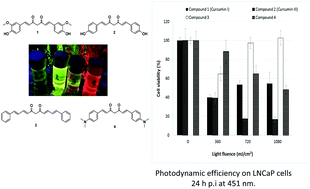当前位置:
X-MOL 学术
›
Photochem. Photobiol. Sci.
›
论文详情
Our official English website, www.x-mol.net, welcomes your
feedback! (Note: you will need to create a separate account there.)
Curcumin derivatives as photosensitizers in photodynamic therapy: photophysical properties and in vitro studies with prostate cancer cells.
Photochemical & Photobiological Sciences ( IF 2.7 ) Pub Date : 2020-01-20 , DOI: 10.1039/c9pp00375d K T Kazantzis 1 , K Koutsonikoli 1 , B Mavroidi 2 , M Zachariadis 3 , P Alexiou 2 , M Pelecanou 2 , K Politopoulos 1 , E Alexandratou 1 , M Sagnou 2
Photochemical & Photobiological Sciences ( IF 2.7 ) Pub Date : 2020-01-20 , DOI: 10.1039/c9pp00375d K T Kazantzis 1 , K Koutsonikoli 1 , B Mavroidi 2 , M Zachariadis 3 , P Alexiou 2 , M Pelecanou 2 , K Politopoulos 1 , E Alexandratou 1 , M Sagnou 2
Affiliation

|
Photodynamic therapy (PDT) is a minimally invasive approach to treat various forms of cancer, based on the ability of certain non-toxic molecules (photosensitizers) to generate reactive oxygen species (ROS) after excitation by light of a certain wavelength and eventually induce strong phototoxic reactions against malignant cells and other pathogens. Curcumin is one of the most extensively investigated phytochemicals with a wide range of therapeutic properties and has been shown to induce strong photocytotoxic effects in micromolar concentrations against a variety of cancer cell lines. Curcumin (1) is comparatively evaluated with the naturally occurring bisdemethoxy Curcumin (2), which lacks the two methoxy groups, as well as two newly synthesized curcuminoids, the cinnamaldehyde derivative (3) and the dimethylamino one (4), designed to increase the absorption maximum and hence the tissue penetration. The synthetic curcuminoids were successfully synthesized in sufficient amounts and their photophysical properties such as absorption, fluorescence, photobleaching and free radical generation were investigated. Compound 4 exhibited a significant increase in peak absorption (497 nm) and strong fluorescent emission signals were recorded for all curcuminoids. Photobleaching of 4 was comparable to 1 whereas 2 and 3 showed more extended photobleaching but much higher ROS production in very short irradiation times. Compounds 2 and 4 exhibited specific intracellular localization. After dark and light cytotoxicity experiments against LNCaP prostate cancer cell line for all curcuminoids, concentration of 3 μM and irradiance of 6 mW cm-2 were selected for the PDT application which resulted in remarkable results with very short LD50. Curcuminoids 2 and 4 exhibited a significant dose-dependent PDT effect. The biphasic dose-response photodynamic effect observed for 1 and 3 may provide a strategy against prolonged and sustained photosensitivity.
中文翻译:

姜黄素衍生物作为光动力疗法中的光敏剂:光物理性质和前列腺癌细胞的体外研究。
光动力疗法(PDT)是一种微创方法,用于治疗各种形式的癌症,其基础是某些无毒分子(光敏剂)在被一定波长的光激发后产生活性氧(ROS)并最终诱导强针对恶性细胞和其他病原体的光毒性反应。姜黄素是研究最广泛的植物化学之一,具有广泛的治疗特性,并且已显示在微摩尔浓度下对多种癌细胞具有强烈的光细胞毒性作用。姜黄素(1)与缺少两个甲氧基的天然双去甲氧基姜黄素(2)以及两个新合成的姜黄素类物质肉桂醛衍生物(3)和二甲氨基之一(4)进行了比较评估,设计用于增加最大吸收量,从而增加组织穿透力。成功合成了足量的姜黄素,并研究了其吸收,荧光,光漂白和自由基生成等光物理性质。化合物4的峰吸收(497 nm)显着增加,并且所有姜黄素均记录到强荧光发射信号。4的光漂白可与1媲美,而2和3则在更短的照射时间内显示出更多的光漂白,但产生的ROS更高。化合物2和4表现出特定的细胞内定位。在针对所有姜黄素针对LNCaP前列腺癌细胞系进行了暗光和光细胞毒性实验后,在PDT应用中选择了3μM的浓度和6 mW cm-2的辐照度,这在很短的LD50情况下产生了显着的结果。姜黄素2和4表现出显着的剂量依赖性PDT效应。对1和3观察到的双相剂量响应光动力效应可能提供了对抗延长和持续的光敏性的策略。
更新日期:2020-02-19
中文翻译:

姜黄素衍生物作为光动力疗法中的光敏剂:光物理性质和前列腺癌细胞的体外研究。
光动力疗法(PDT)是一种微创方法,用于治疗各种形式的癌症,其基础是某些无毒分子(光敏剂)在被一定波长的光激发后产生活性氧(ROS)并最终诱导强针对恶性细胞和其他病原体的光毒性反应。姜黄素是研究最广泛的植物化学之一,具有广泛的治疗特性,并且已显示在微摩尔浓度下对多种癌细胞具有强烈的光细胞毒性作用。姜黄素(1)与缺少两个甲氧基的天然双去甲氧基姜黄素(2)以及两个新合成的姜黄素类物质肉桂醛衍生物(3)和二甲氨基之一(4)进行了比较评估,设计用于增加最大吸收量,从而增加组织穿透力。成功合成了足量的姜黄素,并研究了其吸收,荧光,光漂白和自由基生成等光物理性质。化合物4的峰吸收(497 nm)显着增加,并且所有姜黄素均记录到强荧光发射信号。4的光漂白可与1媲美,而2和3则在更短的照射时间内显示出更多的光漂白,但产生的ROS更高。化合物2和4表现出特定的细胞内定位。在针对所有姜黄素针对LNCaP前列腺癌细胞系进行了暗光和光细胞毒性实验后,在PDT应用中选择了3μM的浓度和6 mW cm-2的辐照度,这在很短的LD50情况下产生了显着的结果。姜黄素2和4表现出显着的剂量依赖性PDT效应。对1和3观察到的双相剂量响应光动力效应可能提供了对抗延长和持续的光敏性的策略。











































 京公网安备 11010802027423号
京公网安备 11010802027423号